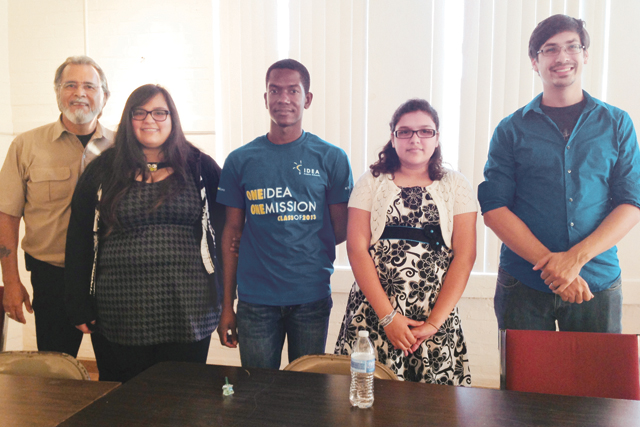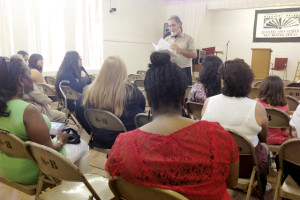
San Benito News photos by Michael Rodriguez
Author Hector Barrera, Ph.D., is seen, from l-r, with the San Benito IDEA Academy students who won the opportunity to illustrate his latest book; they are Savana Jo Dudzienski, Kareem Christmas and Emily Posada. They’re also shown with Christian E. Wilcox, the IDEA Academy art teacher who encouraged the students to submit their artwork. Barrera is shown (below) reading from his book to an audience at the Narciso Martinez Cultural Arts Center in San Benito.
By MICHAEL RODRIGUEZ
Managing Editor
editor@sbnewspaper.com
 California author Hector R. Barrera, Ph.D., recently returned to his hometown of San Benito to debut his latest children’s book and to recognize the students who illustrated it.
California author Hector R. Barrera, Ph.D., recently returned to his hometown of San Benito to debut his latest children’s book and to recognize the students who illustrated it.
It was on the night of June 1 at the Narciso Martinez Cultural Arts Center in San Benito, when Barrera discussed the book and, together with the student illustrators, signed copies for those who attended. One of the more interesting moments of the evening came when Barrera informed the audience that he changed some of the story to match the artwork the students submitted.
“Bart: The Pear Tree that Grew an Apple” was penned by Barrera and illustrated by San Benito IDEA Academy students Kareem Christmas, 17, Savana Jo Dudzienski, 16, and Emily Posada, 11. The students won the opportunity to illustrate the book in the Gold Seal Publisher Art Contest, which was held in conjunction with the San Benito News in 2012, after their teacher, Christian E. Wilcox, encouraged them to participate. Barrera, a San Benito native and Vietnam veteran, is the sole proprietor of Gold Seal Publisher.
A product of El Jardin, one of the oldest and most widely-known neighborhoods in San Benito, Barrera is no stranger to involving the community in his work. Many of his eight books were largely inspired by Barrera’s childhood in San Benito, some of which include “Barrio Trophy,” the story of the Frank Roberts Elementary School football team, the Hornets, that played barefoot yet won a championship; and “Short Stories y Pensamientos.” It’s a sort of practice Barrera has put into effect in nearly all his projects; in fact, when he lived in Seguin, Texas, Barrera was successful in brokering peace between inner-city gangs.
“In my last book, Short Stories y Pensamientos, and in the part about the Greatest Generation and the values of our parents and grandparents, there was a saying: ‘The first 30 years are yours, and anything after that belongs to your family and your community’,” Barrera said about involving San Benito students in the illustration of his book; involvement that won Christmas, Dudzienski and Posada cash prizes as well as the opportunity to become published artists. “So that sort of stays with you. Even though you may leave and move on, this is still my community even though I’m away.”
In his eighth work, Barrera penned a story – or “cuento,” the Spanish word for story and the author’s preferred description of the book – about how grafting roots can create interesting modifications in plant life, such as a pear tree that can grow apples. However, the central themes in “Bart: The Pear Tree that Grew and Apple” actually stem from a social statement – one of change and acceptance. Specifically, Barrera writes about a tree, Bart, that can “trace its lineage back to England” but is suddenly taken aback and even ashamed of a single branch that has suddenly grown an apple. Bart quarantines the branch before eventually accepting it as its own; this after acknowledging the charm and beauty associated with its uniqueness.
Also, Bart, who began to sympathize with the branch, realized that there may have been apple trees in his ancestry.
According to Barrera, one could easily identify the book with that of social topics such as interracial relationships and children born of mixed race. “You want people to think about some of those things,” Barrera said when asked if he intended on making such statements. “Eventually, Bart becomes aware of that fact, that the branch is lonely and how he would feel if he was that branch. Like anything else, there’s also self doubt and he wondered if maybe there were apples who were his ancestors. I want that to reflect as older people read these stories to a child.”
“For example,” Barrera continued, “a teacher telling this story to kids can associate it with what happens when a new baby is born into a family, how family members will react and who will have the most impact on that baby.”
Though written in English, Barrera included several Spanish words in the book to help encourage cultural diversity. In addition, Barrera said there may be a few words (in English) that may challenge his target audience, children in grades first through third. “That’s the reason why I use certain words that a third grader may not know is so adults who are reading the book to the children can explain to them what it means,” Barrera said.
Still, Barrera noted that children will consider “Bart: The Pear Tree that Grew an Apple” a humorous tale, one with relatable and memorable characters while adults will identify with some of the more serious aspects of the story.



Recent Comments